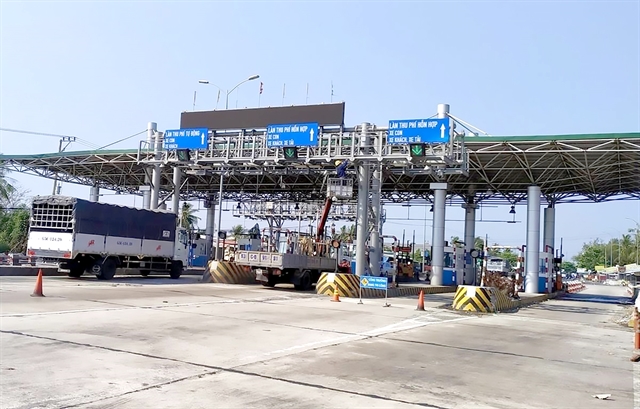
HCM CITY — Many toll stations on roads built under Build-Operate-Transfer (BOT) contracts in the southern region, including HCM City, are improperly located, frustrating the public, especially drivers.
This is evidenced by some road sections densely populated with toll booths and by some of them standing close to schools, causing great inconvenience.
Many southern localities like HCM City, Đồng Nai, Bình Phước and Bình Dương are developing transport infrastructure aimed at enhancing inter-regional connectivity and reducing traffic jams.
The project investors have placed booths on new roads for collecting toll and recovering their investment, but some of these are placed in such a manner that frustrates both local residents and drivers.
For instance, there is a toll station on Hà Nội Highway at the eastern gateway of HCM City; and just a little further, another one for the Phú Mỹ Bridge. About 15km away, there are toll booths on Nguyễn Văn Linh and An Sương – An Lạc section on National Highway 1A.
In Bình Dương Province, three BOT toll stations on National Highway No 13 and Provincial Road No 743 are located at a distance of about 5-7km from each other.
The Vĩnh Phú BOT toll station is placed at the border area between the province’s Thuận An Town and HCM City, which is a crowded intersection with an elementary school located nearby.
The station has set up toll booths at three locations on National Highway No 13 and Provincial Road No 745, charging VNĐ15,000 (US$0.65) per car each way, making it quite expensive for people to travel, especially into Thuận An.
Then there are three toll stations on a 7km-long section of the Provincial Road No 743, charging VNĐ10,000 ($0.43) per car each way.
These are located close to the People’s Committee of Bình Hòa Ward in Thuận An, and a number of public and private kindergartens.
HCM City resident Nguyễn Văn Hậu, 40, told the Sài Gòn Giải Phóng (Liberated Sài Gòn) newspaper that he often commuted from HCM City’s Gò Vấp District through Thuận An and Dĩ An towns in Bình Dương Province to National Highway 1K, transporting goods.
“The distance is less than 10km but I must go through three toll booths and pay tens of thousands of đồng each time. It is very difficult for workers like me,” he said.
A toll booth on National Highway 1K located in a border area between Bình Dương Province’s Dĩ An City and Đồng Nai Province’s Biên Hòa City was suspended in October 2020, but the structure remains, unmaintained, increasing the risk of traffic accidents.
Bình Phước Province is another southern locality that has many toll stations placed too close to each other.
A 159km section of provincial road No 741 running from the province’s Phước Long Town to HCM City has six toll stations with distances of 17.2 to 58km in between them.
Meanwhile there are two toll stations on National Highway No 13 section from Chơn Thành District to the Hoa Lư International Border Gate.
Double dozen
Đậu Văn Dung, a resident in the province’s Bù Đốp District, said he had to pay toll 24 times when going through BOT projects’ booths transporting local agricultural products to HCM City.
“This is one of the reasons why the price of local agricultural products is often higher than in other places,” he said.
Minimum distance
In Đồng Nai, there are six BOT toll stations placed on National Highway 1 in Trảng Bom District and National Highway No 51 in Biên Hòa City managed by the Ministry of Transport; and another located on Provincial Road No 768 in Vĩnh Cửu District which leads to the Tân Cang quarry in Long Thành District, and yet another on road No 319 connecting to the Long Thành – Dầu Giây Expressway managed by the provincial transport department.
Following the Ministry of Finance’s latest regulations, these toll stations are placed at suitable locations with a distance of at least 70km between each other.
Lê Trung Tính, former chairman of HCM City Inter-provincial Passenger Transport and Tourism Association, said the transport sector, including that of passenger transport, was facing many difficulties because of the COVID-19 pandemic and decreasing travel demand.
Functional sectors and localities need to consider reducing road tolls, review booth locations, as well as operation of all toll stations. If any toll station has collected enough investment cost, its operation should be stopped, he said.
To limit the negative impacts of toll booths, the Ministry of Transport has said it is reviewing the situation and planning to strictly control toll collection, avoid losses and adjust the collection period if needed.
One of the most important solutions to control and make revenue collection by BOT projects more transparent is to implement electronic non-stop toll collection (ETC) at all booths.
The ministry has said it will continue to increase the percentage of vehicles using the non-stop toll collection, gradually replacing manual toll collection (MTC).
According to statistics from the Directorate for Roads of Việt Nam, around 2.3 million vehicles have registered for ETC services, about 65 per cent of the nationwide total.
The ministry aims to have 90 per cent of all vehicles registered for ETC this year. — VnExpress News
- Reduce Hair Loss with PURA D’OR Gold Label Shampoo
- Castor Oil Has Made a “Huge” Difference With Hair and Brow Growth
- Excessive hair loss in men: Signs of illness that cannot be subjective
- Dịch Vụ SEO Website ở Los Angeles, CA: đưa trang web doanh nghiệp bạn lên top Google
- Nails Salon Sierra Madre
 VnExpress News The News Gateway of Vietnam
VnExpress News The News Gateway of Vietnam





